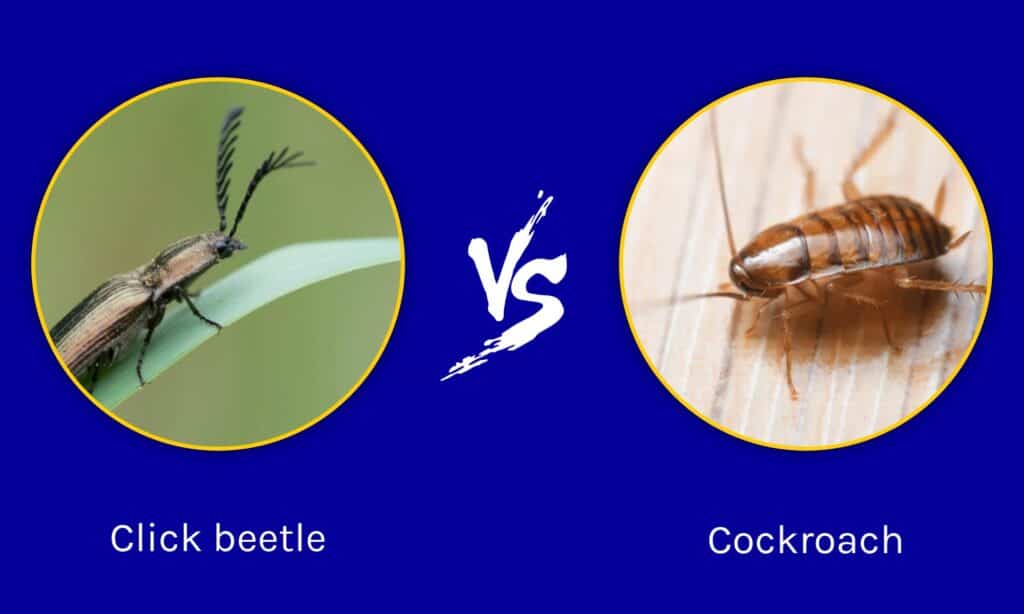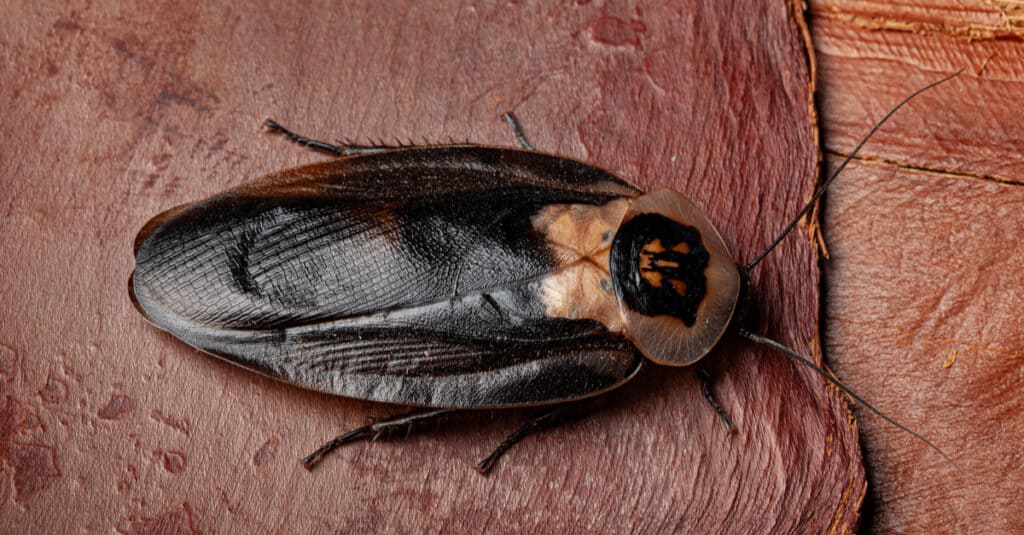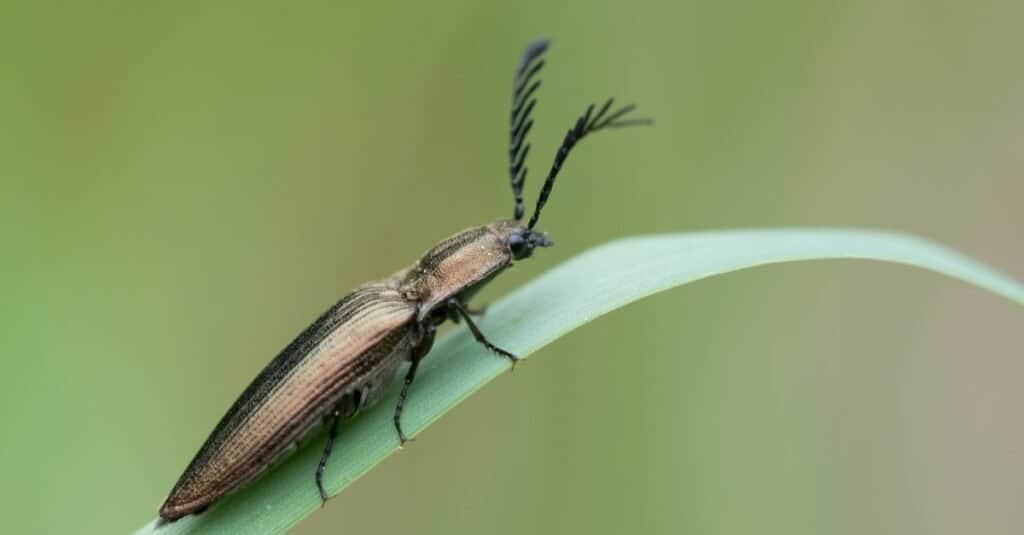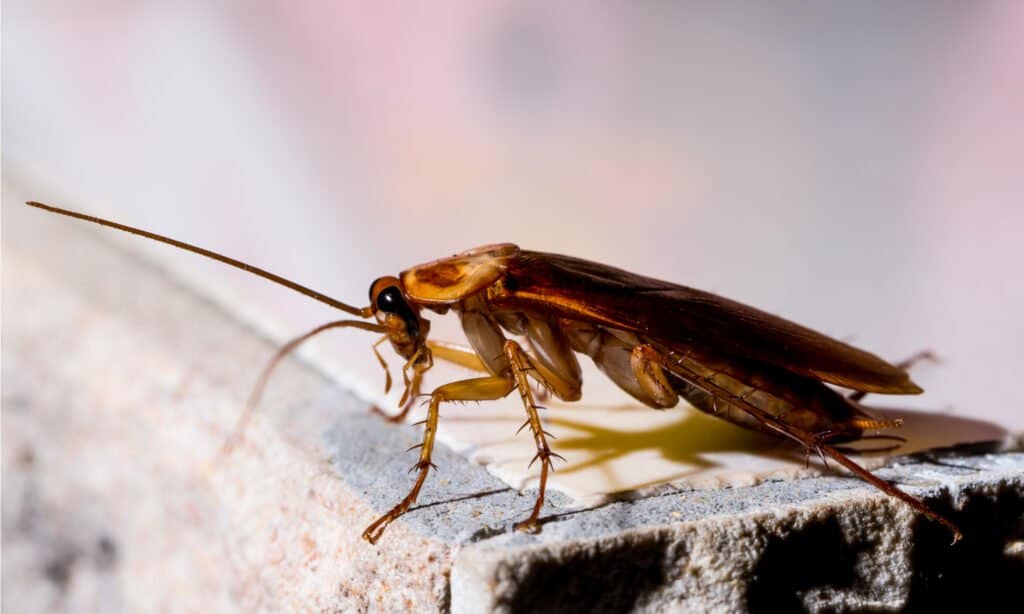Click beetles, as the name implies, are a species of beetles, belonging to the class Insecta. Much like click beetles, cockroaches are also insects and they are widely known for their inclination to infest human homes.
Since they both belong to the same Insecta class, it is quite possible to have trouble differentiating the two. Not to worry, this article explores all the plain and subtle differences between a click beetle vs cockroach alongside some important facts and details.
Comparing a Click Beetle and a Cockroach

| Click Beetle | Cockroach | |
|---|---|---|
| Size | Length: Most are a little under 2cm (0.79 in) | Length: 4cm (1.58 in) |
| Venom | Non-venomous and they have mostly a herbivorous diet. They do not bite. | -Non-venomous and they have an omnivorous diet. – They don’t bite -They also carry a variety of pathogens that spread diseases including dysentery, typhoid, diarrhea, and cholera. |
| Diet | Mostly herbivorous diet – plant juice, foliage, nectar, decaying matter in rotten logs and plant seeds. | Omnivorous diet – they like starches, greasy foods, paper, clothing, dead pests, and virtually anything else as long as it is a derivative of plants or animals. |
| Morphology | Long and rectangular shape. Mostly brown or black bodies. Threadlike antennae with little combs at the top. | Long antennae and dark body Most have wings Mostly dark brown to reddish brown in color |
| Location | Worldwide, in warm climates with a great deal of vegetation | Worldwide, especially in tropical climates. Huge presence in many homes too. |
The Key Differences Between A Click Beetle And A Cockroach
The most salient differences between a click beetle and a cockroach are their size and diets. Most click beetles are a little under 2cm (0.79 in) in length. Cockroaches, on the other hand, are about 4cm (1.58 in) long.
Despite belonging to the famed Insecta class, they are very different from size to diets and even their morphology and habitats. Let’s take a closer look at these differences below.
Clock Beetle Vs Cockroach: Size

A cockroach is twice the size of a click beetle.
©K Hanley CHDPhoto/Shutterstock.com
Cockroaches are about double the size of click beetles on average and they likely also weigh more. The cockroach species boast a length of 4cm (1.58 in) and they weigh about 30 grams (1 ounce) with heights ranging from 35-41mm. Click beetles, however, are 2cm long and some are even shorter than that.
When it comes to size, cockroaches are undoubtedly and incontestably superior to click beetles.
Click Beetle vs Cockroach: Diet
Both of these insects do not have similar diets at all. While click beetles are herbivorous, cockroaches are omnivorous and can eat just about anything that proceeds from a living organism.
Click beetles mostly feed on plants and their diet includes nectar, plant juices, foliage, seeds, sprouts, plant roots, and larvae of other beetles.
Cockroaches however have a diet comprising starches, sweets, greasy substances, cardboard, bread, meat, plastic, hair, soap, toothpaste, dead roaches, leather, feces, fingernails, stamps, and soap among others.
Click Beetle vs Cockroach: Venom

Click beetles are named for their unique clicking sounds.
©Karolsejnova/Shutterstock.com
Both insects (cockroaches and click beetles) are not at all venomous; as a matter of fact, neither of them bite. However, cockroaches can pose threats to humans in some ways. That includes carrying pathogens that spread diseases harmful to the health of humans around them. They are also very social and have a habit of infesting rough and dirty human spaces while making a mess of everything from paper to books to food.
Click beetles, on the other hand, do not bite and they largely have no interest in human things or food. The most threatening part of them is their clocking sound which can be a bit petrifying and that’s saying a lot. However, their larvae (wireworms) can be damaging to crops and seedlings including alfalfa, clovers, corn, cotton, grasses, beans, wheat, oats, and potato tubers among others.
Click Beetle vs Cockroach: Morphology
The very fact that click beetles and cockroaches belong to the Insecta class means they have some sort of similarity in their appearance. For example, they both have antennae, wings as well as similar color schemes. However, even within these seeming similarities, there are differences as we are about to see.
Click beetles are long and rectangular in shape and their bodies are either black or brown. They also have threadlike antennae and a flexible thorax that lets them make the clicking sounds they are widely known for.
Cockroaches are winged and they have super-long antennae, although only a number of species can fly. Cockroach species capable of flight include the Cuban cockroach, the Pennsylvania wood cockroach, and the brown banded cockroach (only males can fly). Also, they are mostly dark brown or reddish brown.
Both animals do not bite humans, however, cockroaches can be way more harmful to humans than click beetles.
Click Beetles vs Cockroaches: Location

Cockroaches are usually found in warm areas.
©PitukTV/Shutterstock.com
Click beetles and cockroaches can both be found anywhere around the world. That simply means you can find them across virtually all the continents. What about their habitats?
Cockroaches have a strong preference for tropical climates. However, they have great adaptive skills and even though they prefer warm temperatures, they can survive in sub-zero weather as well. They like to stay in close proximity to food and water which also explains why they often hang around human homes.
Click beetles also love warm climates with lots of plants and plant materials because of their herbivorous diet.
Click beetles vs Cockroaches: Which is Deadlier to Humans?
We mentioned numerous times before that neither click beetles nor cockroaches are venomous. They don’t even bite in the first place. However, one of them can cause significant harm to humans.
Click beetles are non-venomous, cannot bite, and are largely uninterested in most human foods or things either. They just want to thrive in an area with high vegetation and feed on plants and seeds. Their most threatening characteristic is the clicking sounds they make when they feel attacked.
Cockroaches, on the other hand, are drawn to not-so-clean human homes mostly because they need to survive. They eat human foods, as well as materials in human homes like paper, books, and clothing among others. The ugliest thing about them is their propensity to carry pathogens that can spread diseases including typhoid and cholera which can be debilitating and deadly to humans.
To make it worse, their feces and other body parts contain stenchy pheromones which basically signal other roaches to join and facilitate a full-blown infestation.
The photo featured at the top of this post is © skydie/Shutterstock.com
Thank you for reading! Have some feedback for us? Contact the AZ Animals editorial team.






